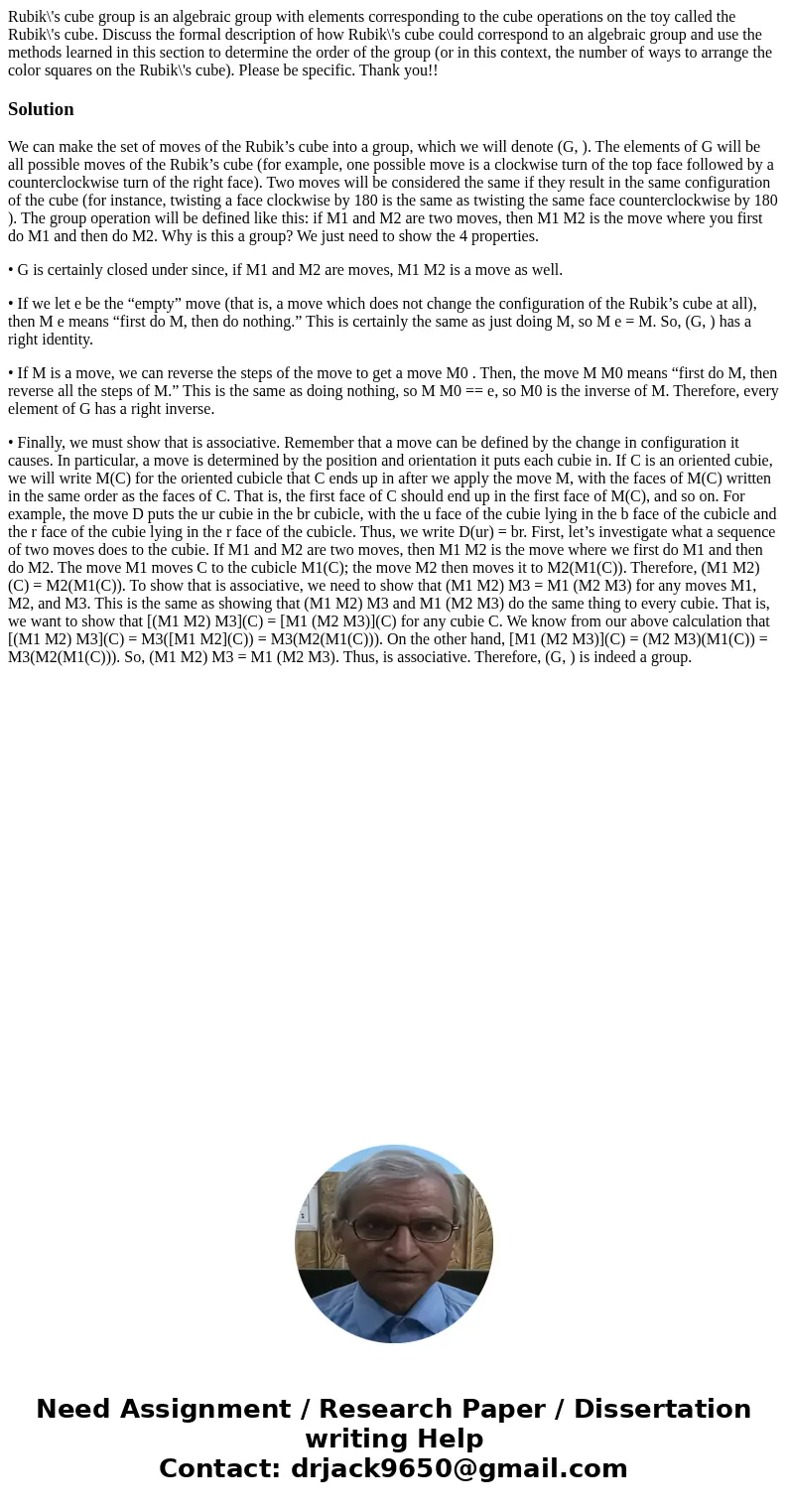Rubiks cube group is an algebraic group with elements corres
Rubik\'s cube group is an algebraic group with elements corresponding to the cube operations on the toy called the Rubik\'s cube. Discuss the formal description of how Rubik\'s cube could correspond to an algebraic group and use the methods learned in this section to determine the order of the group (or in this context, the number of ways to arrange the color squares on the Rubik\'s cube). Please be specific. Thank you!!
Solution
We can make the set of moves of the Rubik’s cube into a group, which we will denote (G, ). The elements of G will be all possible moves of the Rubik’s cube (for example, one possible move is a clockwise turn of the top face followed by a counterclockwise turn of the right face). Two moves will be considered the same if they result in the same configuration of the cube (for instance, twisting a face clockwise by 180 is the same as twisting the same face counterclockwise by 180 ). The group operation will be defined like this: if M1 and M2 are two moves, then M1 M2 is the move where you first do M1 and then do M2. Why is this a group? We just need to show the 4 properties.
• G is certainly closed under since, if M1 and M2 are moves, M1 M2 is a move as well.
• If we let e be the “empty” move (that is, a move which does not change the configuration of the Rubik’s cube at all), then M e means “first do M, then do nothing.” This is certainly the same as just doing M, so M e = M. So, (G, ) has a right identity.
• If M is a move, we can reverse the steps of the move to get a move M0 . Then, the move M M0 means “first do M, then reverse all the steps of M.” This is the same as doing nothing, so M M0 == e, so M0 is the inverse of M. Therefore, every element of G has a right inverse.
• Finally, we must show that is associative. Remember that a move can be defined by the change in configuration it causes. In particular, a move is determined by the position and orientation it puts each cubie in. If C is an oriented cubie, we will write M(C) for the oriented cubicle that C ends up in after we apply the move M, with the faces of M(C) written in the same order as the faces of C. That is, the first face of C should end up in the first face of M(C), and so on. For example, the move D puts the ur cubie in the br cubicle, with the u face of the cubie lying in the b face of the cubicle and the r face of the cubie lying in the r face of the cubicle. Thus, we write D(ur) = br. First, let’s investigate what a sequence of two moves does to the cubie. If M1 and M2 are two moves, then M1 M2 is the move where we first do M1 and then do M2. The move M1 moves C to the cubicle M1(C); the move M2 then moves it to M2(M1(C)). Therefore, (M1 M2)(C) = M2(M1(C)). To show that is associative, we need to show that (M1 M2) M3 = M1 (M2 M3) for any moves M1, M2, and M3. This is the same as showing that (M1 M2) M3 and M1 (M2 M3) do the same thing to every cubie. That is, we want to show that [(M1 M2) M3](C) = [M1 (M2 M3)](C) for any cubie C. We know from our above calculation that [(M1 M2) M3](C) = M3([M1 M2](C)) = M3(M2(M1(C))). On the other hand, [M1 (M2 M3)](C) = (M2 M3)(M1(C)) = M3(M2(M1(C))). So, (M1 M2) M3 = M1 (M2 M3). Thus, is associative. Therefore, (G, ) is indeed a group.

 Homework Sourse
Homework Sourse